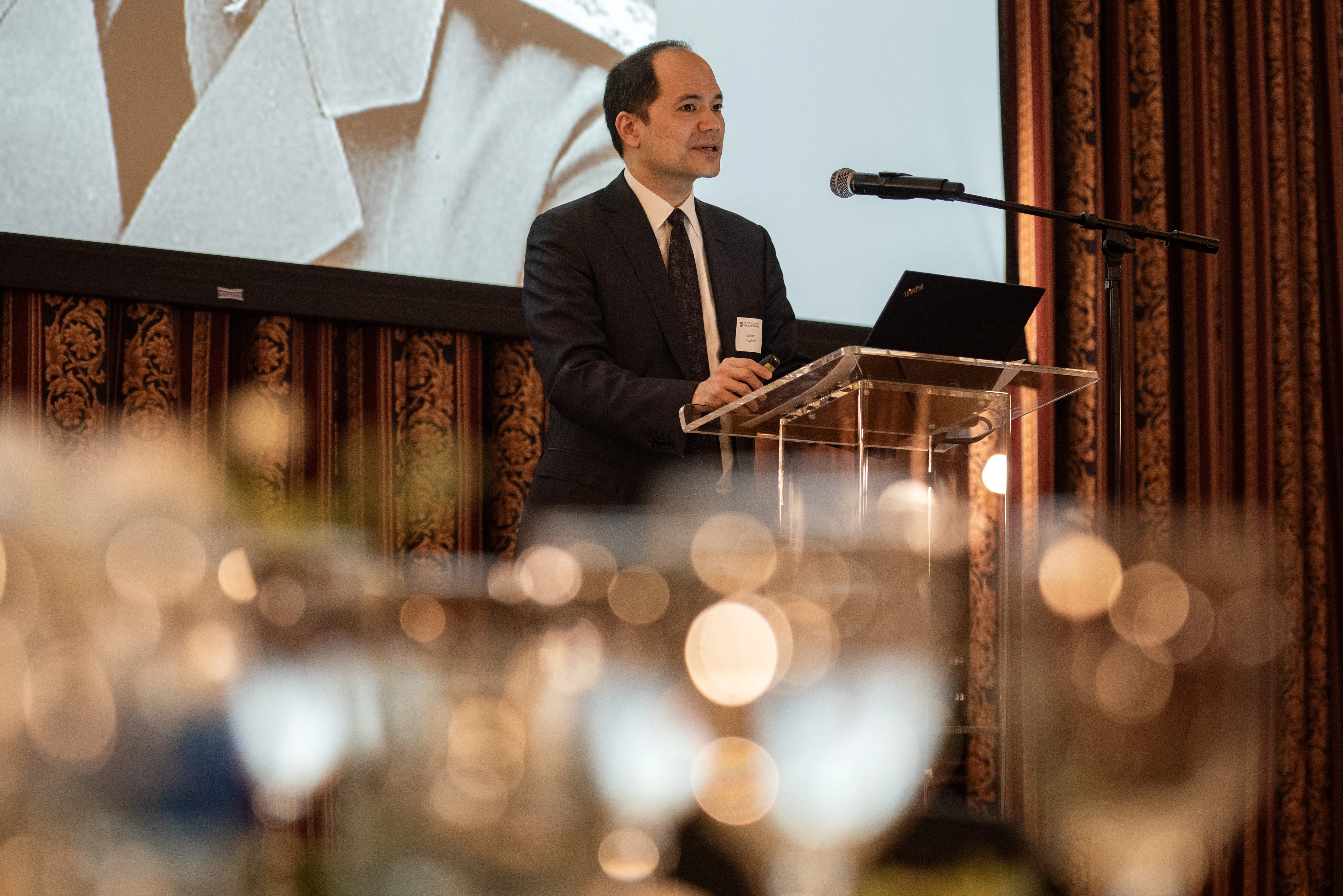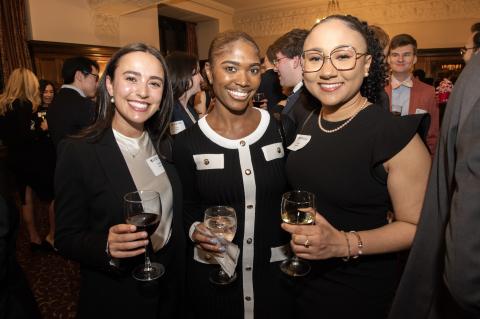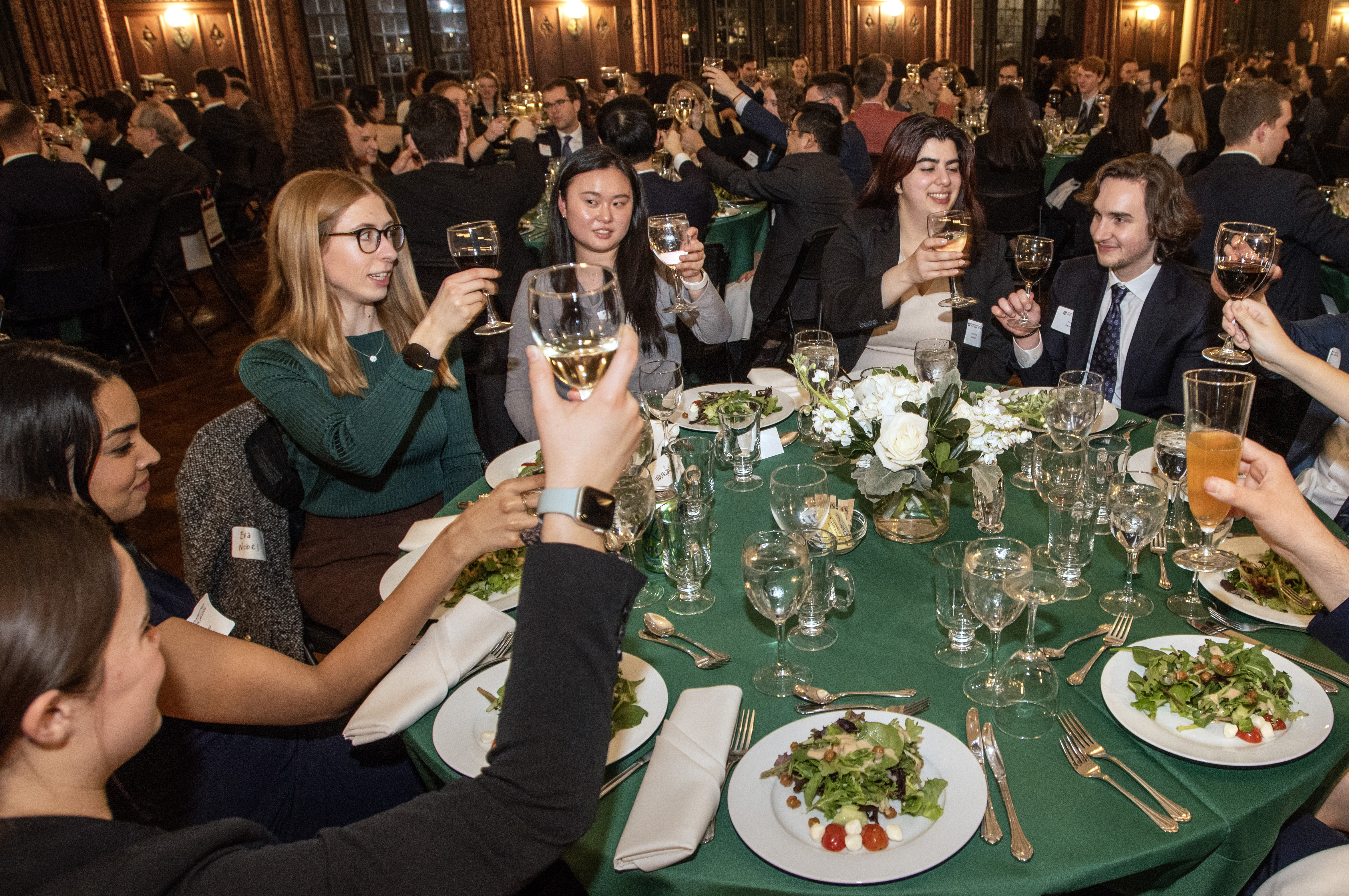‘This Whirlwind ... is the Most Wonderful Part of Law School’

Good evening and thank you all for being here to celebrate the Midway Dinner. Thank you, Dean Miles, for the honor of inviting me to speak at this unique and treasured Chicago tradition. And it is my privilege to congratulate you on all you have accomplished in your first half of law school.
Now, as I think you know, the name of this event, the Midway Dinner, is freighted with meaning. We come across the Midway Plaisance to Ida Noyes Hall, at the midway point of your course of study, and my task as the speaker tonight is to entreat you to “cross the Midway,” to take courses in fields outside of law.
The term “midway” has many more meanings than these, and indeed it’s something of a tradition for the speaker to identify different meanings of “midway” and connect them to this dinner. Professor Lee Fennell, for example, connected the Midway Dinner to the Iditarod sled dog race, the 1893 Columbian Exposition, and the meaning of “midway” as the part of a fair or carnival for sideshows and games. Professor Will Baude managed to be surprising and predictable at the same time, connecting “midway” to . . . James Madison. Who’d have guessed? But also, of course!
So, what else could I possibly say about the idea of “midway”? Well, there’s Midway Airport. One fun fact about Midway Airport, which you might already know, is that despite its location due west of the Midway Plaisance, it is not named after the Midway Plaisance. It’s named after the Battle of Midway, the most important naval battle of World War II and perhaps the most decisive naval engagement in history. And it turns out that the Battle of Midway, like the Iditarod and James Madison, has lessons for us.
Just like the Midway Plaisance sits midway between the Law School and the Main Quad of the University of Chicago, Midway Island sits at almost exactly the halfway point between Asia and North America in the Pacific Ocean. Midway is part of the Hawaiian Islands, and it is an atoll—a collection of tiny islands formed from the remnants of an ancient undersea volcano. To give you a sense of how tiny I’m talking, here are three images, all at exactly the same scale. Midway—the island—is only slightly larger than Midway—the airport—and about the size of the Hyde Park neighborhood.
Its central location in the Pacific Ocean made it strategically important in World War II, and the US military maintained an airbase there. And so, on June 4, 1942, the two most powerful navies in the world would fight the most important naval battle of the war over a tiny speck of sand literally in the middle of the ocean.
This, I suppose, is the first lesson of Midway. You never know when or where opportunities or matters of significance will arise. Keep your ears open, and more importantly, your mind open. You can see the Midway Dinner connection, right? Something unfamiliar or remote, like a class in statistics, or Spanish, or ancient history, might turn out to make a big difference down the road.
Back to Midway Island. I won’t bore you with the details of the battle, but I do want to share some of the background of the lead-up to the battle, which I think captures some additional themes that are worth mentioning.
It is early June 1942, barely half a year after the devastating attack on Pearl Harbor by the Imperial Japanese Navy, which triggered US entry into World War II. In the intervening six months, Japan had won a string of dramatic victories over the United States, Great Britain, and other nations. The most important and powerful naval weapon of World War II was the aircraft carrier, and the biggest and most modern aircraft carriers were called fleet aircraft carriers. In the weeks leading up to the battle of Midway, Japan had four fleet aircraft carriers in operation and the United States had two, the Enterprise and the Hornet. A third US aircraft carrier, the Yorktown, was in dry dock in need of months of repairs after suffering crippling damage in an earlier battle against Japanese aircraft carriers.
So, seeking to capitalize on this advantage, the Commander of the Imperial Japanese Navy, Isoroku Yamamoto, devised a plan to draw the remaining American carriers into battle and destroy them. Japan sent its four strongest aircraft carriers, several battleships, including the most powerful battleship in the world, the Yamato, and dozens of supporting ships. This fleet would launch a surprise attack on Midway Island, drawing the American carriers into battle, and destroying them.
This was a good plan. But there were two things that Admiral Yamamoto did not know. First, the Americans had three carriers ready for battle in June 1942, not two. How could this be? The head of the American Pacific Fleet, Chester Nimitz, knew he would need the Yorktown right away, and repairs crews worked around the clock to complete weeks’ worth of repairs in only three days. Unbeknownst to the Japanese fleet as it closed in on Midway, the Yorktown had returned to sea and joined the American fleet months ahead of schedule.
Thus, the second lesson from Midway: there is no substitute for hard work. It is a cliché, yes, but it is a cliché for a reason. Those welders and laborers on the Yorktown who worked overtime and then overtime again may not have known at the time that were changing world history. But they were. So, feel good about your own toil because you, too, are working toward great things.
“Wait a minute,” you might say. “You said the attack on Midway was a surprise attack. How did Admiral Nimitz know he needed the Yorktown?” This brings us to the second thing that Admiral Yamamoto did not know. American codebreakers had cracked parts of the Japanese naval code, and by late May, they knew that Japan was planning an attack on a location with the codename “AF.” The only problem was that they didn’t know where “AF” was.
The codebreakers had a hunch it was Midway, and they did a very Chicago thing: they came up with a clever way to empirically test their hypothesis. The had the base at Midway send out an unencrypted radio message that they were low on water. Sure enough, the next day the Americans intercepted an encrypted Japanese message reporting that “AF was short on water.” With this confirmation, the American navy was able to prepare for a battle that otherwise could have been a crushing trap.
Thus, the third lesson from Midway: knowledge is power, and even more so when it’s deployed with creativity, and ideas are put to the test. Of course, I don’t need to convince you of the value of ideas! But what is distinctively Chicago in this law school’s approach to legal thought is our willingness to use different methodologies from humanities and social sciences to test and push our ideas about law. And so, I’ll use this lesson as another excuse to encourage you to cross our very own Midway and push your own scholarly knowledge with courses in the humanities and the social sciences.
One last lesson from Midway. Even with the advance warning of the attack, the American navy was rolling the dice. The swift American preparations meant that they were going into battle about evenly matched, rather than at a severe disadvantage. But the battle could still go either way.
The Japanese would not have the element of surprise, it is true. But the Japanese sought to ensure there would be no surprise attack by the Americans, either. So, on the morning of June 4, as the Japanese carriers launched planes to attack Midway Island, the Japanese fleet also launched scout planes to search the surrounding ocean for the presence of the American fleet.
All of the scout planes took off on schedule, at 4:30 am, each one flying out in a different direction to scour the ocean for any sign of American ships. All of them, that is, except one. One of the planes had mechanical trouble and took off half an hour later. And it was that plane that would end up discovering the American fleet—exactly 30 minutes too late.
The rest, as they say, is history. In the ensuing battle, the Japanese aircraft carriers were all destroyed, and the tide of the war turned.
This brings us to the final lesson from Midway: hard work and brains are essential, but they’re not all that matters. Sometimes, you need a lot of luck. We have all had our share of luck to get to this point, to be members of an elite and exclusive community who have access to an honorable, prestigious, and important calling. We should give ourselves credit—but not too much credit. And when luck breaks our way, we should always proceed with gratitude, humility, and generosity, because our success is not all our own doing.
In that spirit of gratitude, let’s just pause to soak in this moment—these days and nights, midway through law school, that you are spending, steeped in your classes, papers, clinics, journals, organizations, activism, research, and everything else. This point in law school feels like a whirlwind, and like a whirlwind, it is fleeting. But it is this whirlwind, this dizzying and unsettled moment that is neither beginning nor end, but midway, that is the most wonderful part of law school. Orientation was an exciting new beginning. Graduation will be joyful and satisfying. But it’s the stuff in between that is why you came to law school, and it is what will make you a great lawyer.
With that in mind, let’s raise a toast to you, to the Law School, to being “midway.” Cheers!


